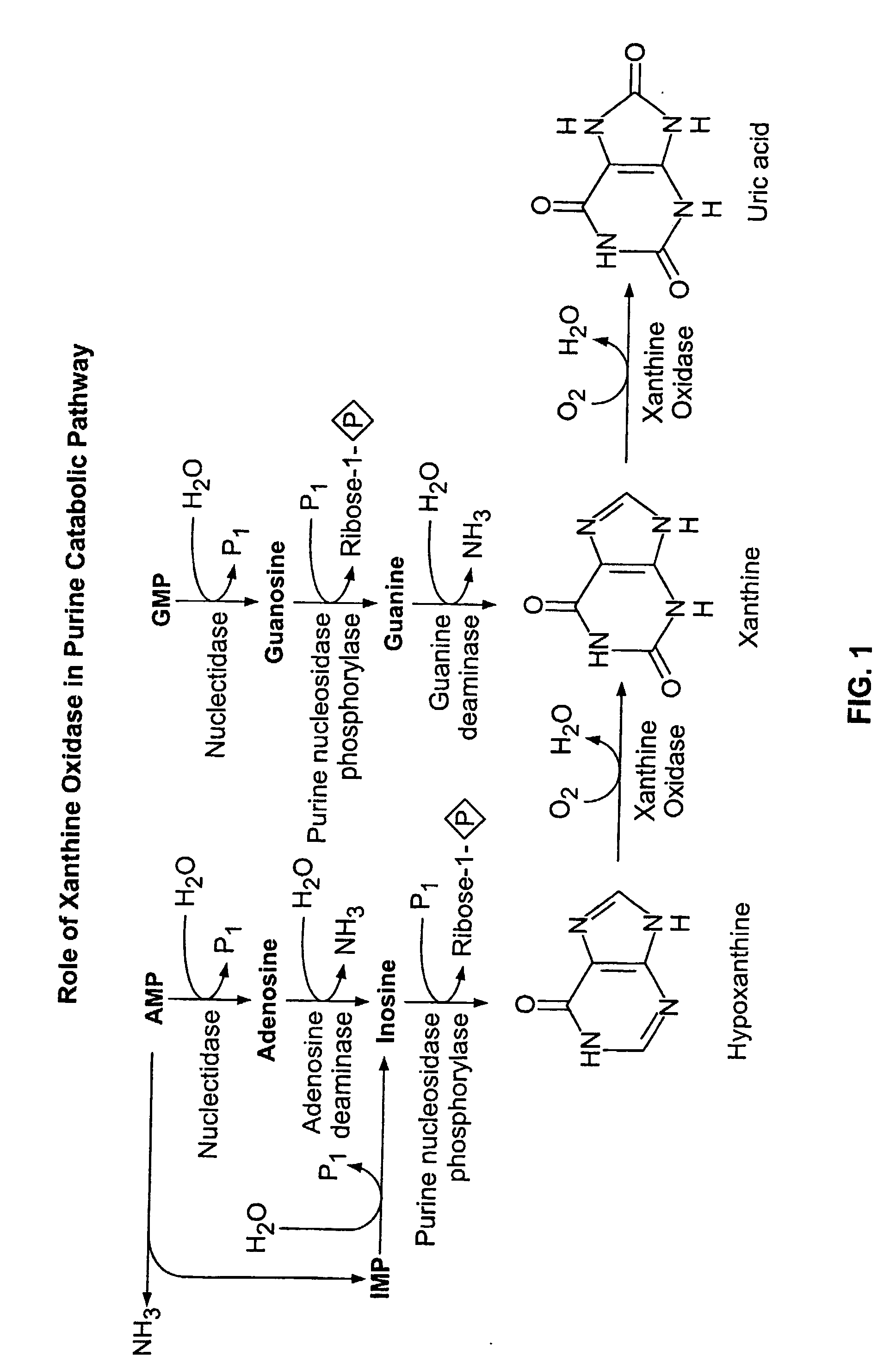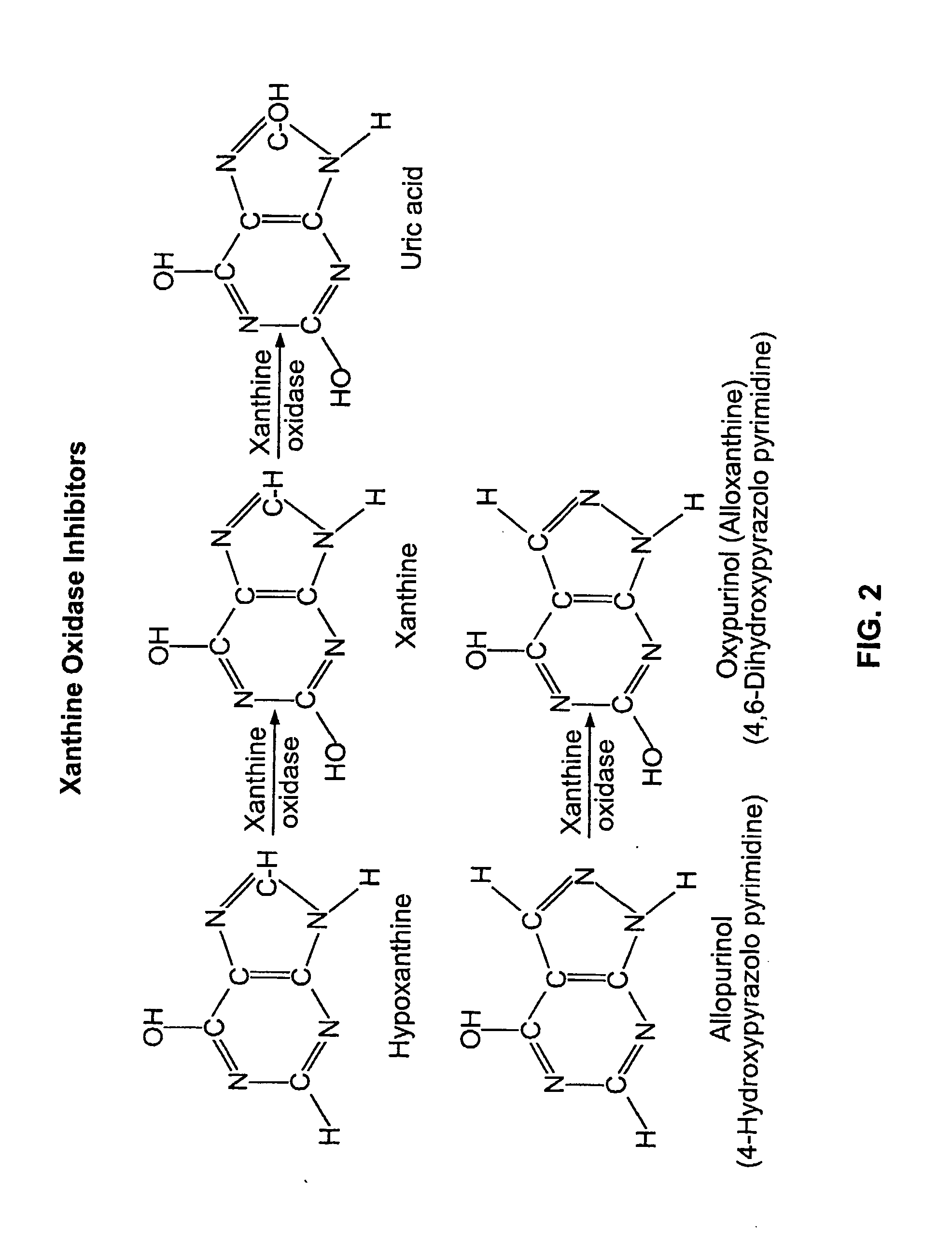Use of Oxypurinol as an Inhibitor of Anti-Neoplastic Agent-Induced Cardiotoxicity
a technology of oxypurinol and neoplastic agents, which is applied in the field of oxypurinol, can solve the problems of limiting the action of agents, causing serious severe side effects, and the best known mode of action of anthracyclines, and achieves the effect of preventing adverse cardiac events or meliorating them
- Summary
- Abstract
- Description
- Claims
- Application Information
AI Technical Summary
Benefits of technology
Problems solved by technology
Method used
Image
Examples
example 1
A Method for Ameliorating or Preventing Anti-Neoplastic Agent-Induced Cardiotoxicity in a Patient Undergoing Chemotherapy
[0100] Patient Selection Criteria
[0101] All patients to be considered for inclusion treatment must be receiving anti-neoplastic agent DOX for either first or recurrent treatment of any malignancy, and willing to undergo cardiac biopsy for determination of anthracycline toxicity.
[0102] In addition, patients with histologically proven, advanced metastatic carcinoma of the breast will also be considered. To be eligible, a patient must have recovered from side effects resulting from previous therapies. Patients who have been previously treated with DOX or other anthracyclines are not considered for this particular study. Patients who had other prior adjuvant chemotherapy can be considered if a recurrence is found within six months after completion of therapy. Patients who have a prior history of other anti-neoplastic hormonal therapy such as tamoxifen citrate, mege...
example 2
A Method for Ameliorating or Preventing Anti-Neoplastic Agent Induced Cardiotoxicity in a Patient Identified as having Recieved an Anti-Neoplastic Agent
Patient Selection Criteria
[0134] Patients who have received anthracyclines within the past 10 years and are found to have unexplained deterioration in cardiac systolic function will be considered for the study. Criteria for inclusion in the study include patients with a normal baseline assessment of left ventricular systolic function prior to the administration of anthracycline, and decline in cardiac function of at least 10% points on echocardiography, nuclear or angiographic ventriculography or cMRI without known interval of mycocardial infarction or ischemia.
[0135] Patients are excluded from study if patients have history of significant obstructive valvular heart disease, obstructive hypertrophic cardiomyopathy or active myocarditis, unstable angina symptoms, MI, stroke or cardiac surgery (including percutaneous intervention) ...
example 3
A Method for Modulating Anti-Neoplastic Agent-Induced Cardiotoxicity in a Patient
[0139] Patient Selection Criteria
[0140] Patients at increased risk for developing a cardiac event are patients with cardiac dysfunction prior to receiving DOX, hypertension, elderly, women, young children, and prior or concurrent radiation therapy.
[0141] DOX is administered intravenously by slow IV push. The doses in those at increased risk for a cardiac event are generally lower cumulative doses to a maximum of 400 mg / m2. As a single agent, 60 to 75 mg / m2 IV as a single dose is administered every 21 days, or 30 mg / m2 IV for 3 days every 4 weeks. When used in combination therapy, 40-50 mg / m2 as a single IV injection is administered every 21 to 28 days. The doses will be adjusted if the patient has inadequate bone marrow reserve caused by old age, has had prior therapy, or neoplastic marrow infiltration. Dose modifications are recommended for the following serum bilirubin levels: for 1.0 to 2.3 mg, re...
PUM
| Property | Measurement | Unit |
|---|---|---|
| volume | aaaaa | aaaaa |
| resistance | aaaaa | aaaaa |
| oxidative stress | aaaaa | aaaaa |
Abstract
Description
Claims
Application Information
 Login to View More
Login to View More - R&D
- Intellectual Property
- Life Sciences
- Materials
- Tech Scout
- Unparalleled Data Quality
- Higher Quality Content
- 60% Fewer Hallucinations
Browse by: Latest US Patents, China's latest patents, Technical Efficacy Thesaurus, Application Domain, Technology Topic, Popular Technical Reports.
© 2025 PatSnap. All rights reserved.Legal|Privacy policy|Modern Slavery Act Transparency Statement|Sitemap|About US| Contact US: help@patsnap.com



